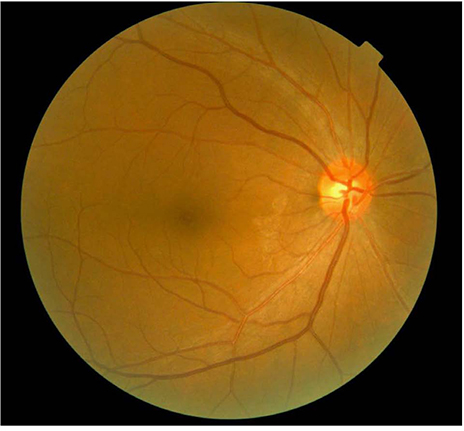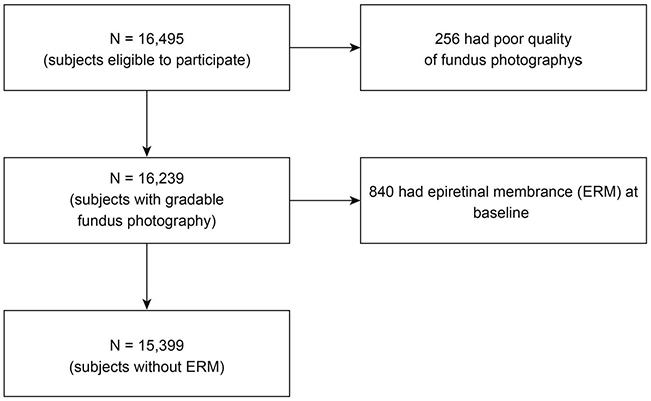J Korean Ophthalmol Soc.
2018 Oct;59(10):922-929. 10.3341/jkos.2018.59.10.922.
The Incidence and Risk Factors of Epiretinal Membrane in a Screened Korean Population
- Affiliations
-
- 1Department of Ophthalmology, Kangbuk Samsung Hospital, Sungkyunkwan University School of Medicine, Seoul, Korea. sjsong7@gmail.com
- KMID: 2422580
- DOI: http://doi.org/10.3341/jkos.2018.59.10.922
Abstract
- PURPOSE
To determine the incidence of idiopathic epiretinal membrane (ERM) and its risk factors in Korean adults.
METHODS
A total of 16,495 participants (≥50 years of age) who had at least two examinations from January 2006 to December 2016 were included in this study. The incidence of idiopathic ERM was determined and age-standardized to the 2010 Korean Census.
RESULTS
Idiopathic ERM developed in 391 of 15,399 participants who had no previous ERM in either eye at the baseline examination. The overall age-standardized incidence was 2.18% (95% confidence interval [CI], 1.89-2.38), including 1.39% with cellophane macular reflex and 0.79% with preretinal macular fibrosis. Multivariate Cox regression analyses revealed that the factor related to the development of idiopathic ERM was obesity (body mass index >25 kg/m2; adjusted hazard ratio, 0.77; 95% CI, 0.60-0.97) after adjusting for confounding factors.
CONCLUSIONS
The incidence of idiopathic ERM in Korean adults was lower than that of other ethnic studies. Further studies are needed to confirm the inverse relationship between obesity and the incidence of ERM in this population.
Keyword
MeSH Terms
Figure
Reference
-
1. Sidd RJ, Fine SL, Owens SL, Patz A. Idiopathic preretinal gliosis. Am J Ophthalmol. 1982; 94:44–48.
Article2. Wise GN. Clinical features of idiopathic preretinal macular fibrosis. Schoenberg Lecture. Am J Ophthalmol. 1975; 79:349–357.3. Klein R, Klein BE, Wang Q, Moss SE. The epidemiology of epiretinal membranes. Trans Am Ophthalmol Soc. 1994; 92:403–425. discussion 425-30.4. Mitchell P, Smith W, Chey T, et al. Prevalence and associations of epiretinal membranes. The Blue Mountains Eye Study, Australia. Ophthalmology. 1997; 104:1033–1040.5. McCarty DJ, Mukesh BN, Chikani V, et al. Prevalence and associations of epiretinal membranes in the visual impairment project. Am J Ophthalmol. 2005; 140:288–294.
Article6. Fraser-Bell S, Ying-Lai M, Klein R, et al. Prevalence and associations of epiretinal membranes in latinos: the Los Angeles Latino Eye Study. Invest Ophthalmol Vis Sci. 2004; 45:1732–1736.
Article7. Miyazaki M, Nakamura H, Kubo M, et al. Prevalence and risk factors for epiretinal membranes in a Japanese population: the Hisayama study. Graefes Arch Clin Exp Ophthalmol. 2003; 241:642–646.
Article8. You Q, Xu L, Jonas JB. Prevalence and associations of epiretinal membranes in adult Chinese: the Beijing eye study. Eye (Lond). 2008; 22:874–879.
Article9. Kawasaki R, Wang JJ, Mitchell P, et al. Racial difference in the prevalence of epiretinal membrane between Caucasians and Asians. Br J Ophthalmol. 2008; 92:1320–1324.
Article10. Kawasaki R, Wang JJ, Sato H, et al. Prevalence and associations of epiretinal membranes in an adult Japanese population: the Funagata study. Eye (Lond). 2009; 23:1045–1051.
Article11. De Bustros S, Rice TA, Michels RG, et al. Vitrectomy for macular pucker. use after treatment of retinal tears or retinal detachment. Arch Ophthalmol. 1988; 106:758–760.12. De Bustros S, Thompson JT, Michels RG, et al. Vitrectomy for idiopathic epiretinal membranes causing macular pucker. Br J Ophthalmol. 1988; 72:692–695.
Article13. Hirokawa H, Jalkh AE, Takahashi M, et al. Role of the vitreous in idiopathic preretinal macular fibrosis. Am J Ophthalmol. 1986; 101:166–169.
Article14. Poliner LS, Olk RJ, Grand MG, et al. Surgical management of premacular fibroplasia. Arch Ophthalmol. 1988; 106:761–764.
Article15. Wise GN. Relationship of idiopathic preretinal macular fibrosis to posterior vitreous detachment. Am J Ophthalmol. 1975; 79:358–362.
Article16. Wiznia RA. Posterior vitreous detachment and idiopathic preretinal macular gliosis. Am J Ophthalmol. 1986; 102:196–198.
Article17. Ng CH, Cheung N, Wang JJ, et al. Prevalence and risk factors for epiretinal membranes in a multi-ethnic United States population. Ophthalmology. 2011; 118:694–699.
Article18. Koh V, Cheung CY, Wong WL, et al. Prevalence and risk factors of epiretinal membrane in Asian Indians. Invest Ophthalmol Vis Sci. 2012; 53:1018–1022.
Article19. Fraser-Bell S, Guzowski M, Rochtchina E, et al. Five-year cumulative incidence and progression of epiretinal membranes: the Blue Mountains Eye Study. Ophthalmology. 2003; 110:34–40.20. Foos RY. Vitreoretinal juncture--simple epiretinal membranes. Albrecht Von Graefes Arch Klin Exp Ophthalmol. 1974; 189:231–250.21. Harada C, Mitamura Y, Harada T. The role of cytokines and trophic factors in epiretinal membranes: involvement of signal transduction in glial cells. Prog Retin Eye Res. 2006; 25:149–164.
Article22. Michels RG. A clinical and histopathologic study of epiretinal membranes affecting the macula and removed by vitreous surgery. Trans Am Ophthalmol Soc. 1982; 80:580–656.23. Savetsky IL, Torrisi JS, Cuzzone DA, et al. Obesity increases inflammation and impairs lymphatic function in a mouse model of lymphedema. Am J Physiol Heart Circ Physiol. 2014; 307:H165–H172.
Article24. Teng KT, Chang CY, Chang LF, Nesaretnam K. Modulation of obesity-induced inflammation by dietary fats: mechanisms and clinical evidence. Nutr J. 2014; 13:12.
Article25. Gopinath B, Baur LA, Teber E, et al. Effect of obesity on retinal vascular structure in pre-adolescent children. Int J Pediatr Obes. 2011; 6:e353–e359.
Article26. Shankar A, Sabanayagam C, Klein BE, Klein R. Retinal microvascular changes and the risk of developing obesity: population-based cohort study. Microcirculation. 2011; 18:655–662.
Article27. DeMarco VG, Aroor AR, Sowers JR. The pathophysiology of hypertension in patients with obesity. Nat Rev Endocrinol. 2014; 10:364–376.
Article28. Kurukulasuriya LR, Stas S, Lastra G, et al. Hypertension in obesity. Med Clin North Am. 2011; 95:903–917.
Article29. Sharma AM. Is there a rationale for angiotensin blockade in the management of obesity hypertension? Hypertension. 2004; 44:12–19.
Article30. Slomko H, Heo HJ, Einstein FH. Minireview: epigenetics of obesity and diabetes in humans. Endocrinology. 2012; 153:1025–1030.
Article31. Cugati S, Wang JJ, Rochtchina E, Mitchell P. Ten-year incidence of retinal vein occlusion in an older population: the Blue Mountains Eye Study. Arch Ophthalmol. 2006; 124:726–732.32. Shin YU, Cho H, Kim JM, et al. Prevalence and associated factors of retinal vein occlusion in the Korean National Health and Nutritional Examination Survey, 2008-2012: a cross-sectional observational study. Medicine (Baltimore). 2016; 95:e5185.33. Gruberg L, Weissman NJ, Waksman R, et al. The impact of obesity on the short-term and long-term outcomes after percutaneous coronary intervention: the obesity paradox? J Am Coll Cardiol. 2002; 39:578–584.34. Hainer V, Aldhoon-Hainerová I. Obesity paradox does exist. Diabetes Care. 2013; 36:Suppl 2. S276–S281.
Article35. Hotamisligil GS. Inflammation and metabolic disorders. Nature. 2006; 444:860.
Article36. Ouchi N, Parker JL, Lugus JJ, Walsh K. Adipokines in inflammation and metabolic disease. Nat Rev Immunol. 2011; 11:85–97.
Article37. Shoelson SE, Lee J, Goldfine AB. Inflammation and insulin resistance. J Clin Invest. 2006; 116:1793–1801.
Article
- Full Text Links
- Actions
-
Cited
- CITED
-
- Close
- Share
- Similar articles
-
- Spontaneous Separation of a Secondary Macular Epiretinal Membrane
- The Clinical Feature of Epiretinal Membrane After Retinal Detachment Surgery
- Incidence and Risk Factors of Epiretinal Membrane Following Acute Posterior Vitreous Detachment
- Surgical Management and Electron Microscopic Features of Idiopathic Epiretinal Membranes
- Electron Microscopic Features of Epiretinal Membrane in Rhegmatogenous Retinal Detachment




